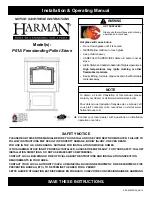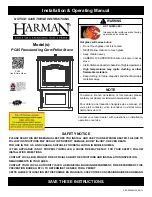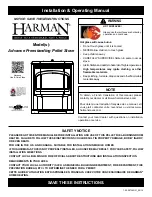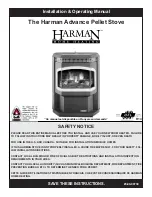
23
DO NOT:
Install or operate the appliance before reading this manual.
DO NOT:
Close the draft beyond the point at which the flames are
completely extinguished.
DO NOT:
Open the appliance door without
fully opening
the draft
first.
DO NOT:
Burn driftwood or wood that has been in salt water. This
includes some mill ends and scrap lumber that has been
floated in salt water on the way to the mill. (This will void
your warranty).
DO NOT:
Handle the plated faceplate unnecessarily. Use the door
handle only.
DO NOT:
Force oversized logs into the firebox as this may dislodge
the baffle assembly.
DO NOT:
Close the door tightly during Burn-In Period.
DO:
Be sure to clean any fingerprints from optional accessories
that have plated surfaces before burning the appliance.
Clean the plated surfaces only with household type glass
cleaner and a very soft cloth.
DO:
Consult local building department if other than recom-
mended clearances are desired.
DO:
Read instructions for the baffle boards and baffle blankets
occasionally to ensure you have not bumped or moved
them out of place when loading wood.
DO
:
Check the chimney and baffle monthly to make sure they are
clean.
DO
:
Burn seasoned, dry wood only! (RAIN = WET WOOD)
DO
:
Open the door frequently during Burn-In Period to keep
gasket from adhering to the curing paint.
DO:
Enjoy the warm feeling of your new IHP appliance.
DO’S AND DON’TS
Smoke Detector Recommended
Since there are always several potential sources of fire in any home, we
recommend installing smoke detectors. If possible, install the smoke
detector in a hallway adjacent to the room (to reduce the possibility of
occasional false activation from the heat produced by these appliances).
If your local code requires a smoke detector be installed within the same
room, you must follow the requirements of your local code. Check with
your local building department for requirements in your area.
Carbon Monoxide Monitor Recommended
Carbon Monoxide Poisoning
: Early signs of carbon monoxide poison-
ing are similar to the flu with headaches, dizziness and/or nausea. If you
have these signs, obtain fresh air immediately. Some people are more
affected by carbon monoxide than others, including pregnant women,
people with heart or lung disease or anemia, those under the influence
of alcohol, and those at high altitudes.
It is against federal regulations to operate wood heaters in a man-
ner inconsistent with operating instructions in the manual.
PROHIBITED FUELS
This heater is designed to burn natural wood only. Higher efficiencies
and lower emissions generally result when burning air dried seasoned
hardwoods, as compared to softwoods or to green or freshly cut hard-
woods. DO NOT BURN:
• Garbage;
• Lawn clippings or yard waste;
• Materials containing rubber, including tires;
• Materials containing plastic;
• Waste petroleum products, paints or paint thinners, or asphalt
products;
• Materials containing asbestos;
• Construction or demolition debris;
• Railroad ties or pressure-treated wood;
• Manure or animal remains;
• Salt water driftwood or other previously salt water saturated mate-
rials;
• Unseasoned wood;
• Christmas tree branches;
• Paper products, colored paper, cardboard, plywood, or particle-
board;
• gasoline;
• naphtha;
• engine oil;
• flammable liquids;
• solvents;
• grease; or
• coal
The prohibition against burning these materials does not prohibit the use
of fire starters made from paper, cardboard, saw dust, wax and similar
substances for the purpose of starting a fire in an affected wood heater.
Burning these materials may result in release of toxic fumes or render the
heater ineffective and cause smoke. Intense firing with these materials
may overheat the fireplace, causing damage to the unit, a fire or even
possibly igniting a chimney fire if the chimney is creosoted. Burning
unapproved fuel, resulting in excessive pollutants being emitted, may be
prohibited and subject to a fine or other penalty by the authority having
jurisdiction in your area.










































